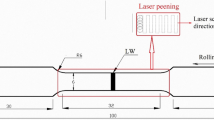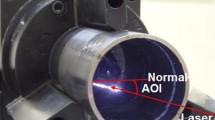Abstract
This communication reports the result of a comparative study of laser marking with conventional mechanical stamping of AISI 304 stainless steel sheet by subjecting the marked specimens to stress corrosion cracking susceptibility test. A single mode fiber laser was made use of for this work to mark the steel specimens while a hydro-pneumatic press was used to effect marking in the conventional way. Mechanically stamped specimens exhibited better resistance to stress corrosion cracking compared to specimens marked with laser. The cracking susceptibility of laser marked samples was found to be critically dependent on the fluence of laser used to cause marking. Extent of cracking was found to increase with fluence. Reduced stress corrosion cracking susceptibility of mechanically stamped specimens was attributed to the presence of compressive residual stresses in and around the mark. This work establishes that upon scaling down its fluence appropriately, a laser can be a workable tool for marking stainless steel components meant for application in corrosive media.










Similar content being viewed by others
Data Availability
No data was used.
References
Kisanov, S.V., Glebov, V.V.: Application of electrochemical marking methods in machine building. Surf. Eng. Appl. Electrochem. 5, 1–4 (2004)
Steen, W.M., Mazumdar, J.: Laser Material Processing. Springer, London (2010)
Qi, J., Wang, K., Zhu, Y.M.: A study on the laser marking of stainless steel. J. Mater. Process. Technol. 139, 273–276 (2003)
Leone, C., Genna, S., Caprino, G., Iorio, D.I.: AISI 304 stainless steel marking by a Q switched diode pumped Nd-YAG laser. J. Mater. Process. Technol. 210, 1297–1303 (2010)
Svanter, M., Kucera, M., Houdkova, S.: Possibilities of stainless steel laser marking. Proccedings of 21st International Conference on Metallurgy and Materials METAL (2012)
Antonczak, A.J., Kocon, D., Nowak, M., Koziol, P., Abramski, K.M.: Laser induced colour marking- sensitivity scaling for a stainless steel. Appl. Surf. Sci. 264, 229–236 (2013)
Antonczak, A. J., Nowak, M., Koziol, P., Kaczmarek, P. R., Waz, A. T., Abramski, K. M: Laser induced colour marking of stainless steel. Proceedings SPIE, Laser Technology 2012 Szczecin, Poland 87030G (2013)
Pacquentin, W., Caron, N., Oltra, R.: Nanosecond laser surface modification of AISI 304L stainless steel : Influence the beam overlap on pitting corrosion resistance. Appl. Surf. Sci. 288, 34–39 (2014)
Vu, T.T., Hoang, H.H: Investigating the Effect of Pulsed Fiber Laser Parameters on the Roughness of Aluminium Alloy and Steel Surfaces in Cleaning Processes. Lasers Manuf. Mater. Process (2021)
Rasheed, B.G., Ibrahem, M.A., Ibrahim, M.H.: Surface Modification of Nobel Metals and Stainless Steel by Pulsed Nd: YAG Laser. Lasers Manuf. Mater. Process. 8, 45–59 (2021)
Ismail, R.A., Hamoudi, W.K., Shakir, Z.S.: Modifications of Hydroxyapatite properties by nanosecond Nd: YAG laser pulses. Lasers Manuf. Mater. Process. 7, 305–316 (2020)
Lecka, K. M., Antonczak, A.J., Szubzda, B., Wojcik, M.R., Stepak, B.D., Szymczyk, P., Trzcinski, M., Ozimek M., Abramski: Effects of laser induced oxidation on the corrosion resistance of AISI 304 stainless steel. J. Laser Appl. 28, 032009–1–9 (2016)
Sunil kumar, B., Kain, V., Banerjee, K., Maniyar, P.D., Sridhar, S., Kumar, J., Kumar J: Effect of oxidation on corrosion behaviour of austenitic steel 304L welds. Adv. Mate.r Res. 794, 598–605 (2013)
Shaikh, H.: Stress Corrosion Cracking of Austenitic Stainless Steel Weldments. In: Khatak, H.S., Raj, B. (eds.) Corrosion of Austenitic Stainless Steels Mechanism, Mitigation and Monitoring, pp. 166–189. Woodhead Publishing, Cambridge (2002)
Raja, V.S., Shoji, T.: Stress Corrosion Cracking Theory and practice. Woodhead Publishing, Cambridge (2011)
Li, Z.L., Zheng, H.Y., Teh, K.M., Liu, Y.C., Lim, G.C., Seng, H.L., Yakovlev, N.L.: Analysis of oxide formation induced by UV laser coloration of stainless steel. Appl. Surf. Sci. 256, 1582–1588 (2009)
Svanter, M., Kucera, M., Smazalova, E., Houdkova, S., Cerstvy, R.: Thermal effects of laser marking on microstructure and corrosion properties of stainless steel. Appl. Optics 55, D35–D45 (2016)
Laakso, P., Pantsar, H., Leinonen, H., Helle, A: Preliminary study on corrosion and wear properties of laser color marked stainless steel. ICALEO, 212–221 (2008)
Valette, S., Steyer, P., Richard, L., Forest, B., Donnet, C., Audouard, E.: Influence of femtosecond laser marking on the corrosion resistance of stainless steels. Appl. Surf. Sci 252, 4696–4701 (2006)
Krawczyk, B., Paul, C., Hobbs, J., Engelberg, D.L.: Atmospheric chloride induced stress corrosion cracking of laser engraved type 316L stainless steel. Corros. Sci 142, 93–101 (2018)
Aniruddha, K., Bhatt, R. B., Biswas, D. J: Parametric characterization of underwater ablation vis a vis laser assisted standard defect simulation in sintered UO2 pellets. J. Nucl. Mater, 540, 152351(2020).
Acknowledgements
The authors wish to acknowledge Pravin Kumar Singh for his assistance during the experiments. They acknowledge the staff of Nano-Functional Materials Lab, RRCAT for providing the SEM images. They also acknowledge S. Pradhan, R.B.Bhatt for their support and encouragement.
Author information
Authors and Affiliations
Corresponding author
Ethics declarations
Conflict of Interest
We do not have any conflict of interest.
Additional information
Publisher's Note
Springer Nature remains neutral with regard to jurisdictional claims in published maps and institutional affiliations.
Appendices
Appendix
Calculation of effective laser fluence per spot area
In the marking process, the laser beam moves with a constant speed of v mm/s at a constant repetition rate, \({R}_{rep}\). A single spot is thereby covered by several pulses as shown in Fig. 11. The diameter of each spot is given by, dspot = \(\frac{4{M}^{2}}{\pi }\frac{f\lambda }{D}\), where f is the focal length of the lens, D is the diameter of the unfocussed beam, M2 is the beam quality parameter and λ is the wavelength of the laser. The percentage overlap of each pulse depends on the focussed beam diameter, repetition rate of the laser and the linear speed of the scanning beam.
Mathematically it is expressed as, % OL = (1 -\(\frac{v}{{R}_{rep}{.d}_{spot}}\)), where v is the speed of the scanning beam, Rrep is the repetition rate of the laser pulses and dspot is the focal spot diameter of the beam. Number of overlapping pulses over a spot area is thus dependent on the spot diameter and percentage overlap of the successive laser pulses. In our experiment the focal spot diameter was measured to be 35 microns, thus percentage overlap with a scanning beam speed of 200 mm/s was calculated to be 94%. Thus each spot was irradiated approximately by seventeen laser pulses. The energy contribution of each overlapping pulse is thus different in the irradiated spot. The contribution of each pulse was thus considered in calculating the effective fluence. The effective energy incident on a spot area due to exposure of N number of pulses, each having energy of E Joule is thus estimated to be,
Effective energy = N \(\left[1- \frac{x}{2{d}_{spot}}\left(N-1\right)\right]E\), where N is the number of pulses irradiating the spot area, x is the distance travelled by the laser beam between two successive pulses, dspot is the focal spot diameter. Effective fluence( Fe) is thus,
Fe = \(\frac{Effective energy per spot area}{area of the focal spot}\)
Rights and permissions
About this article
Cite this article
Kumar, A., Gupta, R.K., Nagpure, D.C. et al. A Comparative Stress Corrosion Cracking Study of Stainless Steel Sheets Marked with Laser and Conventional Mechanical Stamping. Lasers Manuf. Mater. Process. 8, 409–425 (2021). https://doi.org/10.1007/s40516-021-00154-2
Accepted:
Published:
Issue Date:
DOI: https://doi.org/10.1007/s40516-021-00154-2





